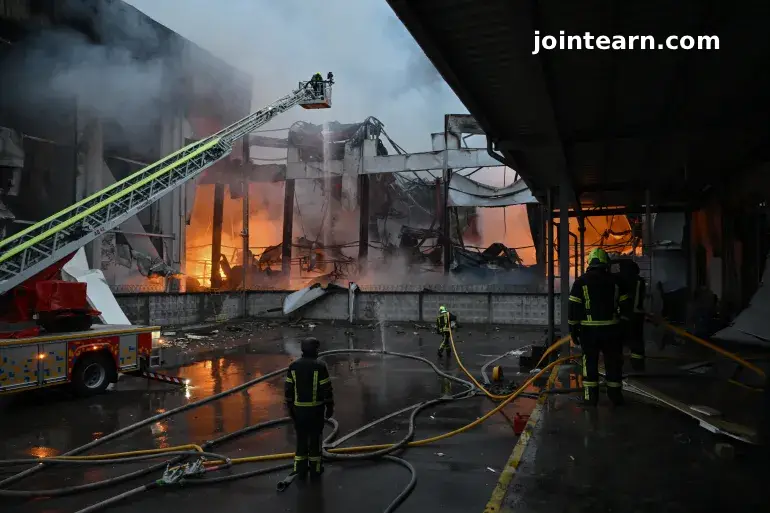
Kyiv, Dnipropetrovsk hit by fresh missile and drone attacks amid new U.S. and EU sanctions targeting Russian energy exports.
Deadly Strikes Hit Kyiv and Dnipropetrovsk
KYIV, October 25, 2025 — At least four civilians were killed and more than a dozen injured after Russian missile and drone strikes hit several regions of Ukraine overnight, as Western nations intensified sanctions on Moscow to mark nearly four years since the start of the full-scale invasion.
According to Kyiv’s military administration, two people were killed in the capital and nine others were wounded when ballistic missiles struck non-residential areas early Saturday. Debris from intercepted missiles damaged nearby apartment buildings and vehicles, sparking fires across the city.
“Explosions in the capital. The city is under ballistic attack,” said Kyiv Mayor Vitali Klitschko in a social media post shortly after the strikes.
The Ukrainian State Emergency Service reported that emergency crews battled a large blaze at a warehouse site, while shrapnel from downed missiles shattered windows and caused structural damage in residential districts.
In the Dnipropetrovsk region, local authorities confirmed two additional deaths and at least seven injuries, including first responders caught in a secondary strike.
“One rescuer was killed and another wounded as a result of a repeated missile strike on the Petropavlivska community,” Ukraine’s Ministry of Internal Affairs said.
Ukraine’s Air Defences Tested by Massive Barrage
Ukraine’s Air Force Command said Russia launched a barrage of nine Iskander-M ballistic missiles and 62 Shahed-type drones in the coordinated assault. Ukrainian defences intercepted four missiles and 50 drones, preventing greater casualties and infrastructure damage.
The Russian Ministry of Defence did not comment on the attacks, which follow a series of escalating cross-border strikes by both sides this month.
Meanwhile, Russia accused Ukraine of targeting a dam in the Belgorod region, claiming that repeated strikes had increased flood risks. Regional Governor Vyacheslav Gladkov advised residents in Shebekino and Bezlyudovka to evacuate.
The Russian Defence Ministry claimed to have shot down 121 Ukrainian drones overnight, describing it as one of the largest attempted attacks on Russian territory to date.
Global Pressure Mounts as War Nears Fourth Year
The fresh wave of violence coincides with renewed Western sanctions designed to pressure Russian President Vladimir Putin to negotiate an end to the war.
This week, the United States and European Union announced sweeping new measures targeting Russia’s oil, gas, and financial sectors.
On Wednesday, U.S. President Donald Trump imposed sanctions on major Russian energy giants Rosneft and Lukoil, calling the move “essential to ending Moscow’s aggression.” The EU followed on Thursday with a ban on Russian liquefied natural gas (LNG) imports, signaling a coordinated effort to isolate Russia economically.
At a joint press conference in London, Ukrainian President Volodymyr Zelenskyy welcomed the sanctions but urged further action, including restrictions on all Russian oil exports and accelerated delivery of air defence systems to Ukraine.
“It is because of such attacks that we pay special attention to Patriot systems,” Zelenskyy said. “We must protect our cities from this horror. Partners who possess such capability must act now.”
Putin Rejects Western Demands
In response, President Vladimir Putin denounced the latest sanctions as an “unfriendly act” and vowed Russia would not bow to Western pressure.
“No self-respecting nation makes decisions under coercion,” Putin said during a televised address. “We will defend our sovereignty by all means necessary.”
The Kremlin maintains its demand for Ukraine’s complete demilitarization and insists on retaining occupied territories, a stance Kyiv continues to reject outright.
President Trump, who has repeatedly claimed he could end the war “within 24 hours” if both sides agreed to talks, has struggled to bridge the divide between Moscow and Kyiv. Plans for a Trump–Putin meeting fell apart this week after the U.S. president proposed a temporary ceasefire based on current front lines — a plan dismissed by Kyiv as legitimizing occupation.
Despite diplomatic deadlock, Putin’s envoy Kirill Dmitriev suggested on Friday that a “mutually acceptable compromise” might soon emerge, though he provided no details.
War’s Fourth Winter: Humanitarian Toll Grows
As Ukraine prepares for its fourth winter at war, humanitarian agencies warn of worsening conditions for millions of civilians facing blackouts, fuel shortages, and freezing temperatures. The latest airstrikes have damaged critical infrastructure, including power substations and food storage facilities, deepening fears of a prolonged energy crisis.
The United Nations Office for the Coordination of Humanitarian Affairs (OCHA) estimates that over 14 million Ukrainians remain displaced or in need of aid.
“Each new attack pushes Ukraine closer to a humanitarian catastrophe,” said OCHA spokesperson Elena Kovalenko. “We need sustained international assistance to prevent mass suffering this winter.”
Analysis: A War Entrenched and Evolving
Analysts say both sides appear locked into a strategic stalemate, with Russia relying on drone and missile attacks to erode Ukraine’s resilience, while Ukraine intensifies cross-border strikes and diplomacy to maintain global attention.
Political scientist Serhiy Koshulynsky notes that sanctions alone may not compel Moscow to negotiate.
“Economic pressure is vital, but as long as Russia can sell oil to non-Western buyers, sanctions will have limits,” he said. “The outcome now hinges on sustained Western unity — and Ukraine’s ability to hold the line militarily.”
Conclusion: Rising Tensions, Diminishing Options
Saturday’s attacks highlight the enduring volatility of the war, as both military escalation and diplomatic paralysis deepen the world’s most dangerous geopolitical standoff in decades.
With winter approaching and sanctions tightening, the next few months could prove decisive in determining whether Ukraine’s resistance strengthens or fractures, and whether Russia’s strategy of attrition begins to falter under global isolation.
Leave a Reply